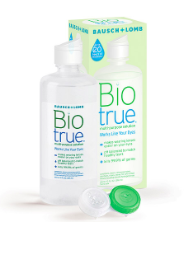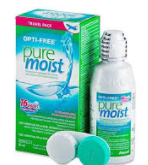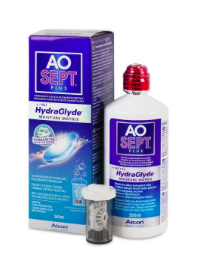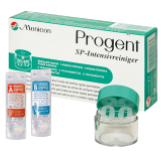Scleral Contact Lenses
Your Complete Guide to Scleral Contact Lenses
What are scleral contact lenses?
Scleral contact lenses are large-diameter gas permeable (GP) contact lenses that rest on the sclera (white of the eye) and not directly on the cornea. They contain silicone that is oxygen permeable, so oxygen can pass through the lens giving greater comfort and better eye health. Scleral lenses can also provide clearer vision, durability, deposit resistance and can be easier to clean.
Are scleral lenses comfortable to wear?
Yes, because they rest on the sclera which is a lot less sensitive than the cornea. It may take between 5 to 10 days before they settle in completely. Scleral lenses provide initial comfort similar to soft lenses, especially for sensitive eyes or irregularly shaped corneas. Because of their size, scleral lenses are more stable on the eye than conventional GP lenses, so they are less likely to accidentally dislodge from the eye. This stability also can make them more comfortable than conventional GP lenses. .
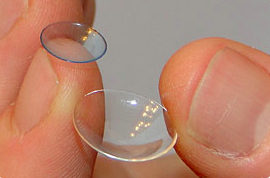
Scleral lenses are larger than GP conventional lenses. They are called “scleral” lenses because, instead of covering only a portion of the cornea (like conventional GP lenses), these large lenses vault over the entire corneal surface and rest on the “white” of the eye (the sclera)
How does a scleral lens correct distorted vision?
If you have had previous eye surgery/trauma or have a condition called Keratoconus then your cornea may be irregular in shape. A scleral lens vaults right over the top of your cornea to provide a new clear, regular surface for the light to refract on. Between the back surface of the scleral lens and your eye, your tears and moisturising gel fill in any irregularities resulting in clearer vision with reduced glare and haloes.
How long will scleral lenses last?
If the lenses are well cared for and kept clean they can last for up to 2 years, in some cases even longer. We recommend regular 6 monthly checks and as long as the lenses are fitting safely, providing clear vision and are comfortable, there is no need to change them.
Daily wear time:
On your first day, start at between 3-4 hours of wear and for every day after that try for up to 1 hour longer. Many people who wear scleral lenses are able to wear them for 12-14 hours daily. However some people may need to remove the lenses, clean them, and reapply them with fresh moisturising gel periodically throughout the course of the day in order to maintain the best possible vision and comfort.
How do I insert my scleral lenses?
1. Thoroughly wash and dry your hands.
2. Remove the lens from its case, and rinse with multipurpose solution.
3. Hold the lens with 2-3 fingers or balance the lens on a suction holder.
4. Fill the lens to the top with Theratears Gel. If it is not full to the top you might let air bubbles into the lens. If you find the Gel too thick or if you notice dried gel on your eyelashes, try to insert the contact lenses with Theratears Drops instead.
5. Lean forward until your face is parallel to the floor or table, keep both eyes wide open and look straight ahead (ie. directly down).
6. Pull back the upper lid with your left thumb or forefinger, make sure to hold right near the eyelashes. Pull the lower eyelid out of the way with your left middle or ring finger.
7. Your right hand is still holding the lens either between fingers or on a suction holder.
8. Focus on the centre of the lens as it approaches your eye. Gently apply the lens directly onto the eye. If using a suction cup, SQUEEZE the barrel to release the lens onto the eye and remove the suction holder. Do not allow any air bubbles to get into the lens.
9. If the lens does not feel comfortable, remove it, clean it and re-insert.
Note: The suction holder should be cleaned regularly with your contact lens cleaner rinsed with preserved saline and left to air-dry.
How do I remove my scleral lenses?
1. Look upwards. Pull down the lower lid with your right index finger so that it is just below the inferior edge of the lens.
2. Pull up the top lid with your left index finger so that it is just above the superior edge of the lens.
3. Push gently but firmly into the sclera (“white” of your eye) through the lid margins so that the suction at the edge of the lens is broken and a large air bubble is introduced under the lens.
4. The lens can then be lifted off the eye.
Note: It is normal for the eye to feel slightly dry or look slightly red following lens removal. This should only last for 5 minutes. Lubricants can help. If this lasts for more than 30 minutes please let us know.
For more information, please visit the following website and watch the video about insertion and removal of scleral lenses: www.sclerallens.org
How to take care of your lenses – General tips for successful contact lens wear
Always wash your hands before handling your contact lenses or eyes
Wash your hands with soap and running water, remembering to rinse your hands thoroughly. Dry your hands with a towel. Ensure your nails are clean and not too long. Use non-cosmetic soap as soaps with lotions or oils in them can transfer to the contact lens and cause irritation on lens application along with blurred vision.
Cleaning of your contact lenses
It is important to clean your scleral contact lenses daily to maintain the highest standards of comfort and visual clarity. Each day after you remove your lenses, you must digitally clean them prior to overnight storage.
ALWAYS use the prescribed cleaning solution, which serves as a cleanser and disinfectant. It also increases the comfort of your contact lenses.
NEVER use saliva, saline or water of any type. Tap, distilled and bottled water (and particularly saliva) contain bacteria and viruses which may be absorbed by the contact lens and cause eye infections. Sterile saline is NOT a disinfectant nor are contact lens rewetting drops.
1. For rinsing your lenses, use BioTrue or Opti-free Puremoist.
2. Place the lens bowl-side up in the palm of your hand and apply a few drops of biotrue. With the pad of your finger gently rub the entire lens in a circular motion against the palm of your hand. Be sure to thoroughly clean the entire lens and then rinse it well in a steady stream of biotrue.
3. For disinfection use AOSept Hydrogen Peroxide Disinfection System. Carefully follow the instructions for the specific disinfection system you use. Always soak lenses in the provided lens case for at least six hours prior to inserting into the eye, so we recommend you do it overnight.
4. Use only the case provided with the AOSept disinfection system. You must soak the lenses a minimum of 6 hours before inserting again. Never put AOSept directly into the eye. Never rinse lenses with AOSept prior to
insertion into the eye. Solution must be neutralized. Never use AOSept® Plus in a flat lens case.
5. Always use fresh solution when storing your lenses. Never “top off” or use old solution. Old solution should NEVER be re-used.
6. Do NOT allow the tip of the solution bottle to come into contact with any surface and keep the solution bottle tightly closed when not in use.
7. Always discard the old lens case to avoid contamination and ensure proper neutralization.
8. Never dry out your lenses with a tissue or a towel as it will scratch the front and back surfaces of the lenses, making them uncomfortable and decreasing your quality of vision.
9. To get rid of protein deposits (if advised by your optometrist), once a fortnight, use Progent Intensive Cleaner. Carefully follow the instructions for the specific disinfection system you use. NOTE: Never put Progent directly into the eye. We supply this at Eye5, it can be hard to find elsewhere.
Expiry date of solution
Always check the expiry date of the solution. When you open a new bottle, write the date you need to discard it (generally 3 months after opening) on the container in a felt tip pen. Do not use out-of-date solution.
Contact lens cases
Bacteria can accumulate in contact lens cases. After putting in your contact lenses, the case should always be emptied, rinsed out with cleaning solution (Biotrue or Optifree puremoist) – NEVER water – then wiped with a clean tissue and air-dried. A new contact lens case is included with every purchase of contact lens cleaning solution. Always throw away the old case and use the new one. Contact lens cases should be replaced if damaged or cracked.. The case should be filled up to the top of the line with solution (if over-filled, the lens may ride up and be damaged by the lid).
Never wear a contact lens for longer than it is designed for
The use of the contact lenses past these dates is NOT recommended as the lenses are not structurally or functionally designed to last any longer. The material often breaks down after this date, causing irritation and poor vision.
Do not sleep in your contact lenses
In most cases you should remove scleral lenses before sleeping. Stagnation of the tear layer behind the lens could lead to a higher risk of eye infection. Since most of the people who need scleral lenses have already had some trouble with their eyes, further challenge to the surface of the eye would not be advisable.
Swimming and Water sports
The safest option is to wear goggles and thoroughly disinfect the lens afterwards. Water contains germs, which may then contaminate the contact lens. Wearing your contact lenses after these activities would be the same as wearing your wet swimsuit. In the event you get water splashed in your eyes, make sure to remove your lenses and clean them thoroughly.
It is not recommended to swim in fresh water even if it’s flowing freely due to the risk of infection from Acanthamoeba, which can cause severe loss of vision.
Contact lens use when in hospital or unwell
Avoid wearing contact lenses in hospital or while unwell. Hospitals are often sources of infection. When you are sick (even just with a cold or flu) you risk spreading infection to your eye via contact lenses.
Avoid wearing contact lenses on a plane
The humidity in aircraft cabins is very low. If you wear your contact lenses they will become very dry and uncomfortable and you will arrive at your destination with sore eyes. Please wear your spectacles for flying if at all possible. Ideally insert your contact lenses just after arriving at your destination.
When travelling
Use a smaller size bottle of solution, do NOT transfer solutions into small containers.
FAQ’s
What are the normal adaptation symptoms I can expect?
While you are first getting used to your lenses you may notice some or all of the following:
- Variable vision due to increased tear production
- Stinging, itching and abnormal blinking
- Lens edge awareness particularly felt with your eyelids
- Increased glare sensitivity – wear sunglasses
- Initial discomfort with lots of close work/computer work – use more lubricant eye drops
- Dryness in air-conditioning and smoky areas – use more lubricants and try cleaning your lenses mid way through the day
- You may also notice a slight blur to your vision when you wear spectacles straight after removing your contact lenses. This should clear within 30 minutes.
What is abnormal?
Persistent redness, discomfort, pain, blurred vision or if bright lights hurt your eyes. If these occur stop all lens wear and make an appointment to see us. “If in doubt take your lenses out.”
One of my contact lenses is suddenly uncomfortable, what should I do?
The first thing to do is to take the lens out. Does that fix the problem? If so, it is probably due to the lens rather than your eye itself. Now clean the lens thoroughly and put it back in. If that fixes the problem then there might have been something on the lens. If not then remove the lens again.
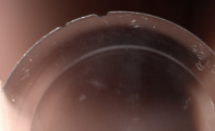
You also need to carefully examine the edge of the lens in bright light. You might notice a small chip out of the edge of the lens. The lens would need to be replaced so please contact us.
In the above scenario if you remove the lens but your eye is still hurting, it is likely that there is something wrong with your eye. That means it would be best to come and see us straight away to have it checked.
Aftercare schedule for your lenses
We normally like to see you about 1-4 weeks after picking up your lenses and then again at 2 months, 6 months and at least every 6-12 months thereafter. This is so we can review the health of your eyes and suggest any improvements in your contact lens prescription, lens design or material.
If you do not return for regular aftercare checks, we are legally unable to supply you with contact lenses, as they are a health appliance.
Always wear your contact lenses to your contact lens appointments, having had them in for at least 4 hours. Please remember to bring your case and spectacles with you.
Consultation Fees
Initial examination – $299
> includes initial and follow up appointment, trial contact lenses, teaching insertion and removal of contact lenses, starter multipurpose solution cleaning kit,
Cost of scleral contact lenses
$1500 per pair. (Please note: all prices are subject to change at any time.)
Warranty
We have 3 months to change the parameters until we find the perfect fitting for your eyes. We offer a 50% CREDIT if lens is unsuccessful. Sorry, we do not provide warranty for loss of lenses.
What happens if I break my lens?
New lenses are covered by a warranty against breakage and chipped edge for the first 3 months (Please note: you will need to ensure you return the broken lens). After this time we will replace the lens to the same prescription at a 30% discount.
Should I keep a spare set on hand?
It is a good idea to have a spare set of lenses on hand because a new set can take 10-14 days to be made. We can offer a 30% discount on all duplicate lenses purchased. Please speak to your Optometrist for the details.
Refunds
We can give a 50% CREDIT on scleral contact lenses. Please note we do not give refunds on fitting fees. Please see our office policy or speak to your optometrist for further details.
Book an eye test with us
Want to find out if scleral contact lenses are right for you? Book an appointment with us today!
